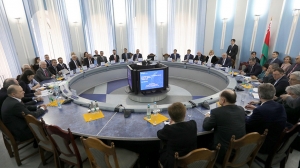Five useful practices singled out by IAEA's INIR 3 mission in Belarus

MINSK, 4 March (BelTA) – As a result of the Integrated Nuclear Infrastructure Review (INIR 3) mission to Belarus the International Atomic Energy Agency (IAEA) has singled out five positive practices that can be used by other countries. Deputy Director General, Head of the IAEA Nuclear Energy Department Mikhail Chudakov made the statement as he summed up results of the mission in Belarus on 4 March, BelTA has learned.
Mikhail Chudakov said: “As a result of the mission seven recommendations were issued and five positive practices other countries may use in the course of creating infrastructure were singled out.”
The positive practices were registered in such areas as coordination of programs and projects, use of independent expert reviews, cooperation with regulatory authorities of other countries, interaction with international parties concerned, and efforts to ensure preparedness for emergencies.
Belarusian Deputy Energy Minister Mikhail Mikhadyuk explained the mission's recommendations focus on the improvement of development of the national nuclear energy infrastructure in several areas. For instance, the national electric company Belenergo took over the management of the state enterprise Belarusian Nuclear Power Plant as of 2020, this is why recommendations were issued on how to correctly build relations between Belenergo and the nuclear power plant's operating enterprise. The recommendations also concern repairs and maintenance of the nuclear power plant.
The IAEA's Integrated Nuclear Infrastructure Review (INIR 3) mission worked in Belarus on 24 February – 4 March. The group included one expert from Algeria, two experts from the UK, and seven IAEA specialists. The IAEA experts analyzed the Belarusian nuclear energy industry infrastructure in all the 19 areas of the industry's development specified by the IAEA Milestones Document for emerging nuclear energy countries. It was the second INIR mission sent to Belarus.
In the course of the mission a Belarusian report on developing all aspects of the nuclear infrastructure was reviewed, conferences in the format of interviews were held with Belarusian experts to discuss all these aspects. Representatives of the Energy Ministry, the Emergencies Ministry, the Ministry of Foreign Affairs, the Natural Resources and Environmental Protection Ministry, the Education Ministry, the Healthcare Ministry, and the joint energy and nuclear research institute Sosny of the National Academy of Sciences of Belarus, representatives of the Belarusian electric company Belenergo, and the state enterprise Belarusian Nuclear Power Plant took part in events organized in the course of the mission.
The Belarusian nuclear power plant is being built near Ostrovets, Grodno Oblast using a Russian design featuring two VVER-1200 reactors with the total output capacity of 2,400MW. Rosatom's engineering division – ASE Company – is the general contractor. The first unit is supposed to go online in 2020, with the second one scheduled for launch in 2021.













